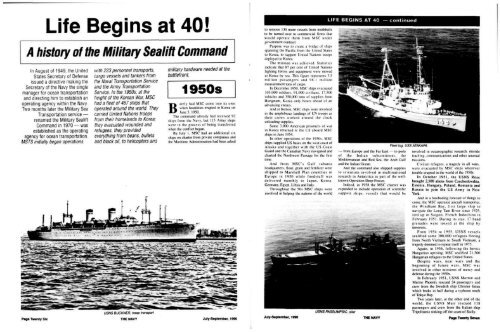Jul and Oct 1990 - Navy League of Australia
Jul and Oct 1990 - Navy League of Australia
Jul and Oct 1990 - Navy League of Australia
You also want an ePaper? Increase the reach of your titles
YUMPU automatically turns print PDFs into web optimized ePapers that Google loves.
Life Begins at 40!<br />
A history <strong>of</strong> the Military Sea lift Comm<strong>and</strong><br />
In August <strong>of</strong> 1949. the United<br />
States Secretary <strong>of</strong> Defense<br />
issued a directive making the<br />
Secretary <strong>of</strong> the <strong>Navy</strong> the single<br />
manager for ocean transportation<br />
<strong>and</strong> directing him to establish an<br />
operating agency within the <strong>Navy</strong><br />
Two months later the Military Sea<br />
Transportation service —<br />
renamed the Military Sealift<br />
Comm<strong>and</strong> in 1970 — was<br />
established as the operating<br />
agency for ocean transportation.<br />
MSTS initially began operations<br />
P»ge Twenty Six<br />
with 223 personnel transports,<br />
cargo vessels <strong>and</strong> tankers from<br />
the Naval Transportation Service<br />
<strong>and</strong> the Army Transportation<br />
Service. In the 1950s, at the<br />
height <strong>of</strong> the Korean War. MSC<br />
had a fleet <strong>of</strong> 467 ships that<br />
operated around the world. They<br />
carried United Nations troops<br />
from their homel<strong>and</strong>s to Korea;<br />
they evacuated wounded <strong>and</strong><br />
refugees, they provided<br />
everything from beans, bullets<br />
<strong>and</strong> black oil. to helicopters <strong>and</strong><br />
USNS BUCKNER, troop transport<br />
military hardware needed at the<br />
battlefront.<br />
1950s<br />
B<br />
arely had MSC come into its own<br />
when hostilities erupted in Korea on<br />
June 5. 1950.<br />
The comm<strong>and</strong> already had received 92<br />
ships from the <strong>Navy</strong>, but II5 Army ships<br />
were in the process <strong>of</strong> being transferred<br />
when the conflict began.<br />
By <strong>Jul</strong>y I, MSC had an additional six<br />
ships on charter from private companies <strong>and</strong><br />
the Maritime Administration had been asked<br />
THE NAVY Jury-Svptmbw, <strong>1990</strong><br />
to remove 130 more vessels from mothballs<br />
to be turned over to commercial firms that<br />
would operate them from MSC under<br />
government contract.<br />
Purpose was to create a bridge <strong>of</strong> ships<br />
spanning the Pacific from ihe United Stales<br />
to Korea, to support I'nited Nations troops<br />
deployed to Korea.<br />
The mission wu achieved. Statistics<br />
indicate that 87 per cent <strong>of</strong> United Nations<br />
fighting forces <strong>and</strong> equipment were moved<br />
to Korea by sea. This figure represents 3.5<br />
million passengers <strong>and</strong> 98,1 million<br />
measurement tons <strong>of</strong> cargo.<br />
In December 1950. MSC ships evacuated<br />
105.000 soldiers. 91.000 civilians. 17,500<br />
vehicles <strong>and</strong> 350,000 tons <strong>of</strong> supplies from<br />
Hungnam. Korea only hours ahead <strong>of</strong> an<br />
advancing enemy.<br />
And al Inchon. MSC ships were involved<br />
in the amphibious l<strong>and</strong>ings <strong>of</strong> UN troops as<br />
their crews worked around the clock<br />
unloading supplies.<br />
Some 3.000 American prisoners <strong>of</strong> war<br />
in Korea returned tc the US aboard MSC<br />
ships in June 1954.<br />
In other operations <strong>of</strong> the 1950s. MSC<br />
ships supplied US bases on the west coast <strong>of</strong><br />
Alaska <strong>and</strong> together with the US Coast<br />
Guard <strong>and</strong> the Canadian <strong>Navy</strong> navigated <strong>and</strong><br />
charted Ihe Northwest Passage for the first<br />
time.<br />
And from MSC's Gulf subarea<br />
headquarters, flour, gram <strong>and</strong> fertiliser were<br />
shipped to Marshall Plan countries in<br />
Europe in 1950 while foodstuff was<br />
delivered monthly to Japan. Korea.<br />
Germany, Egypt. Libya <strong>and</strong> Italy.<br />
Throughout the 50s MSC ships were<br />
involved in helping the nations <strong>of</strong> the world<br />
<strong>Jul</strong>y -September. <strong>1990</strong><br />
LIFE BEGINS AT 40 — continued<br />
USNS PASSUMPSIC. oiler<br />
— from Europe <strong>and</strong> the Ear East — to ports<br />
<strong>of</strong> the Indian subcontinent, the<br />
Mediterranean <strong>and</strong> Red Sea, the Arab Gulf<br />
<strong>and</strong> the Indian Ocean.<br />
And the comm<strong>and</strong> also shipped supplies<br />
to scientists involved in multinational<br />
research in Antarctica as part <strong>of</strong> the wellknown<br />
Operation Deep Free/c.<br />
Indeed, in 1958 the MSC charter was<br />
exp<strong>and</strong>ed to include operation <strong>of</strong> scientific<br />
support ships, vessels that would be<br />
Fleet tug, USS ATAKAPA<br />
involved in oceanographic research missile<br />
tracking, communications <strong>and</strong> other unusual<br />
missions.<br />
Civilian refugees, a tragedy in all wars,<br />
were evacuated by MSC ships wherever<br />
trouble erupted in the world ol the 1950s.<br />
In <strong>Oct</strong>ober 1951. the USNS Rose<br />
brought 2.500 aliens from Czechoslovakia.<br />
Estonia. Hungary, Pol<strong>and</strong>. Romania <strong>and</strong><br />
Russia to join the US Army in New<br />
York.<br />
And in a foreboding forecast ot things to<br />
come, the MSC operated aircraft transporter,<br />
the Windham Ray. first large ship to<br />
navigate the Long Tarn River since 1925.<br />
tied up in Saigon. French Indochina in<br />
February 1951. During its stay. 17 h<strong>and</strong><br />
grenades were tossed at the ship by<br />
terrorists<br />
From 1954 to 1955. USNS vessels<br />
scaliftcd some 300.000 refugees fleeing<br />
from North Vietnam to South Vietnam, a<br />
tragedy doomed to repeat itself in 1975.<br />
Again, in 1956. following the heroic<br />
Hungarian uprising. MSC scaliftcd 21.500<br />
Hungarian refugees to the United States.<br />
Despite wars, near wars <strong>and</strong> the<br />
beginning <strong>of</strong> future wars. MSC was<br />
involved in other missions <strong>of</strong> mercy <strong>and</strong><br />
defense during the 1950s.<br />
In February 1951, USNS Morton <strong>and</strong><br />
Marine Phoenix rescued 24 passengers <strong>and</strong><br />
crew from the Swedish ship Christcr Salen<br />
which broke in half during a typhoon north<br />
<strong>of</strong> Tokyo Bay.<br />
Two years later, at the other end <strong>of</strong> the<br />
world, the USNS Mutr rescued 118<br />
passengers <strong>and</strong> crew from the Italian ship<br />
Tripolitania sinking <strong>of</strong>f the coast <strong>of</strong> Sicily.<br />
Page Twenty Seven

















